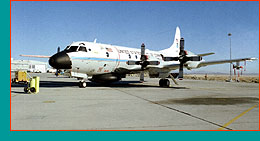 |
 |

|
Editor's Note: Early Monday morning (February 2), online producer Mark Hoover journeyed into the heart of the largest storm this season, off the coast of California. For a brief description, read his dispatch The Heart of a Storm. For a full account, see Storm Flight. Storm Flightby Mark Hoover Anxious eyes scan the early-warning pacific storm system screens. A Japanese satellite has detected a massive low-pressure system organizing a thousand miles north of Hawaii. In an El Niño winter, when a major storm brews far out at sea in the Pacific, and hitches itself to the jetstream for an express train ride to California, it's hunker-down time on the coast, a time of preparation and concern. At the Naval Research Laboratory in Monterey, they've been prepared for a long time, and concerned that a monster storm wouldn't strike. 
Airmen in every sense of the word, NOAA meteorologists, working in conjunction with Navy researchers and aircrews, plan a series of flights from Monterey directly toward-and through-the worst storms the Pacific can spit out this winter. Their mission: to use their aircraft itself as a meteorological instrument, as well as to drop dozens of specialized dropsondes, tiny weather stations equipped with a telemetry radio, out of the plane as it fights its way through the storms. These sondes, sending streams of data as they fall through the conflagration to the ocean five miles below, let researchers create a three-dimensional picture of the storm, and determine whether El Niño storms have as much bite...or more...than a winter storm in a normal year. Their aircraft is the venerable P-3; a large, blunt-nosed, four-engine turboprop built to take the worst nature can dish out. With a crew of eight-plus our NOVA Online correspondent-the P-3 will roar out of Monterey, heading west northwest as it speeds out to its fateful rendezvous. On the periphery of the storm, the shaking begins, and builds to a wrenching, juddering crescendo as the craft pushes through the howling winds and finally pierces the heart of the storm. Every minute, another whoosh and a bang indicate a crewman has released a dropsonde through the special door in the floor of the plane. Outfitted with instruments recording every conceivable aspect of the storm, the plane is a flying weather station doing the only El Niño research in the world conducted from within a major storm. Photo: NASA Dryden Flight Research Center Anatomy of El Niño | Chasing El Niño | El Niño's Reach Dispatches | Resources | Mail | Site Map | El Niño Home Editor's Picks | Previous Sites | Join Us/E-mail | TV/Web Schedule About NOVA | Teachers | Site Map | Shop | Jobs | Search | To print PBS Online | NOVA Online | WGBH © | Updated November 2000 |